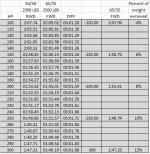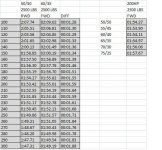Two points to make now that we seem to be done with the factual side of the discussion:
1. Facts seem to show that ITS and ITR could use a bigger weight break than A, B and C. I think some earnest time on LapSim with some study of lap times (oh the horror!) to backup the LapSim models could produce and accurate number if one were desired. The laptimes wouldn't be to 'correct' the cars to equivalent laps, just to verify that the LapSim models produce the right results at the right tracks.
I feel like I missed the juicy part of this while I was away from the internets so...Rant On:
Greg seems to not desire an actual number and would rather have his vast experience pick as arbitrary a number as we currently have (what apparent idiot chose the current correction? clearly that guy was no greg ). Even though in the first round of LapSim numbers Mike and I ran we came up with some backup for greg's ass numbers I don't agree with the 'vast experience' argument. It's a bit insulting to the group, the process and many of the members here who may, god forbid, know more then him on this subject but are still trying to do it the right way. Quite odd to start this whole discussion with no plan to back your position up.
). Even though in the first round of LapSim numbers Mike and I ran we came up with some backup for greg's ass numbers I don't agree with the 'vast experience' argument. It's a bit insulting to the group, the process and many of the members here who may, god forbid, know more then him on this subject but are still trying to do it the right way. Quite odd to start this whole discussion with no plan to back your position up.
Rant Off:
2. Even though I have some data to say that the current numbers might not be perfect I still have to ask what problem we are trying to solve. Is it that we have two classes not currently dominated by FWD honda products?
As an ITA CRX racer I aspire to one day build an ITR or ITS car that is more capable than my CRX. One big factor in this capability is RWD. If the GSR or a Prelude were the car to have in ITS/R I would be headed out of IT (what's the point of different classes if they have basically the same cars with a bit more motor?). The OK-ness of FWD ends when you need to take an engine's worth of weight out of the car to make it work, that's dumb and we're gaming the system if we do it.
Alex
1. Facts seem to show that ITS and ITR could use a bigger weight break than A, B and C. I think some earnest time on LapSim with some study of lap times (oh the horror!) to backup the LapSim models could produce and accurate number if one were desired. The laptimes wouldn't be to 'correct' the cars to equivalent laps, just to verify that the LapSim models produce the right results at the right tracks.
I feel like I missed the juicy part of this while I was away from the internets so...Rant On:
Greg seems to not desire an actual number and would rather have his vast experience pick as arbitrary a number as we currently have (what apparent idiot chose the current correction? clearly that guy was no greg
Rant Off:
2. Even though I have some data to say that the current numbers might not be perfect I still have to ask what problem we are trying to solve. Is it that we have two classes not currently dominated by FWD honda products?
As an ITA CRX racer I aspire to one day build an ITR or ITS car that is more capable than my CRX. One big factor in this capability is RWD. If the GSR or a Prelude were the car to have in ITS/R I would be headed out of IT (what's the point of different classes if they have basically the same cars with a bit more motor?). The OK-ness of FWD ends when you need to take an engine's worth of weight out of the car to make it work, that's dumb and we're gaming the system if we do it.
Alex
Last edited:



